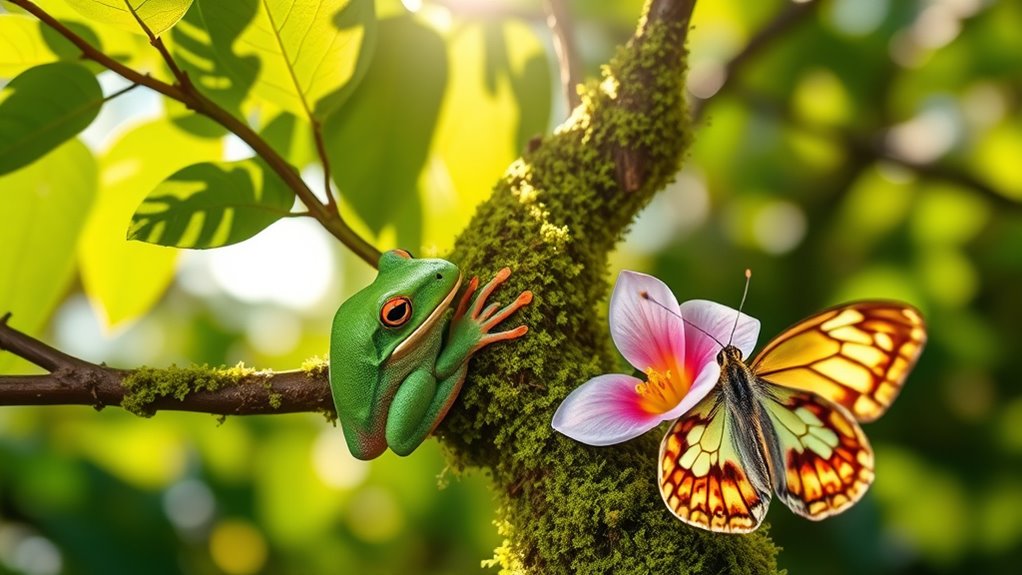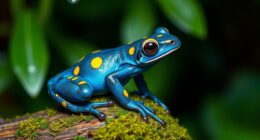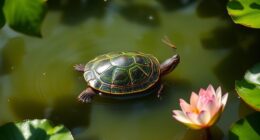Camouflage and mimicry are fascinating survival tactics in nature. You’ll find species like chameleons and certain insects expertly blending into their surroundings to avoid predators. Meanwhile, some animals mimic the appearance of dangerous species, tricking their would-be hunters. These clever adaptations highlight the ongoing evolutionary battle between prey and predators. By understanding these strategies, you can gain a deeper appreciation for the complexity of survival in the animal kingdom, revealing more astonishing details about these techniques.
Key Takeaways
- Camouflage allows prey to blend into their environment, reducing visibility to predators and enhancing survival chances.
- Mimicry involves imitating the appearance of dangerous species to deter potential predators, adding complexity to survival strategies.
- The predator-prey dynamic drives the evolution of both camouflage and mimicry, fostering continual adaptation and survival techniques.
- Many species utilize deception mechanisms, such as color changes or shape mimicry, to evade detection and thrive in their ecosystems.
- Understanding these survival tactics reveals the intricate relationships and creative adaptations present in nature’s ecosystems.

Have you ever wondered how some animals manage to vanish into their surroundings? The art of camouflage is a fascinating survival tactic that many species employ to evade predators or sneak up on prey. You might find it surprising how effective these strategies can be. Think about it: a chameleon effortlessly blends in with the leaves around it, or a flounder lying flat against the sandy ocean floor. These aren’t just random occurrences; they’re well-developed adaptations that have evolved over time.
Predator strategies play an essential role in this game of hide-and-seek. Predators rely on keen eyesight and acute senses to track down their next meal. They’ve developed methods to enhance their hunting prowess, whether it’s stalking quietly through the underbrush or using the element of surprise. But here’s the catch: the prey is just as smart. Prey adaptations, like camouflage, give them an edge in avoiding detection. This constant battle between predator and prey drives the evolution of these remarkable survival techniques.
Predators sharpen their skills, but clever prey use camouflage to outwit them in nature’s relentless game of survival.
Take the case of the stick insect. At first glance, you might think you’re looking at a twig. This impressive mimicry serves a dual purpose: not only does it help the insect hide from potential predators, but it also allows it to blend in with the vegetation, making it easier to feed on leaves without drawing attention. You can see how this evolutionary dance plays out in countless species, each trying to outsmart the other.
Mimicry adds another layer of complexity to the survival game. Some animals don’t just blend in; they mimic the appearance of other, often more dangerous species. For instance, the harmless king snake looks remarkably similar to the venomous coral snake. This clever ruse can deter potential predators who mistake the king snake for a more dangerous meal. It’s a brilliant example of how deception can be a powerful tool in nature.
In the end, understanding camouflage and mimicry gives you a deeper appreciation for the intricate relationships between species. Each adaptation is a tribute to nature’s creativity and the ongoing struggle for survival. Additionally, many animals also rely on transfer switch mechanisms to enhance their survival strategies. So, the next time you’re out in nature, take a moment to look a little closer. You might just spot a master of disguise hiding in plain sight, demonstrating how survival often relies on the art of deception.
Frequently Asked Questions
How Do Animals Develop Their Camouflage Abilities Over Time?
Animals develop their camouflage abilities over time through evolutionary adaptations shaped by predator-prey dynamics. You’ll notice that those with better camouflage survive longer, passing their traits to offspring. As environments change, natural selection favors individuals that blend in, allowing them to avoid detection. Over generations, this process fine-tunes their appearance, making them more efficient at hiding from predators or ambushing prey, ensuring their species thrives in a constantly shifting world.
Are There Examples of Human Use of Mimicry in Nature?
Yes, humans use mimicry in nature, often for predator deception. For instance, researchers found that some indigenous tribes imitate bird calls to hunt effectively, showcasing evolutionary mimicry. This allows them to lure animals into traps, demonstrating how humans have adapted similar strategies. Remarkably, studies show that about 20% of bird species can be mimicked by skilled hunters. By leveraging these techniques, you can enhance your connection with nature and improve your survival skills.
What Role Does Camouflage Play in Animal Mating Behaviors?
Camouflage plays a vital role in animal mating behaviors by enhancing visual signaling. When you observe animals, you’ll notice how some use their colors or patterns to blend into their surroundings, making them less visible to predators. This deceptive strategy allows them to attract mates without drawing unwanted attention. For instance, a brightly colored male might hide among flowers, showcasing his vibrant hues while avoiding being seen by predators lurking nearby.
How Does Climate Change Affect Camouflage Effectiveness?
Climate change can seriously affect camouflage effectiveness; studies show that 40% of species may struggle to adapt as habitats shift. As temperatures rise and environments alter, animal colors and patterns often fail to match their surroundings. This camouflage deterioration makes them more visible to predators and mates. If you want to help wildlife, support conservation efforts focused on climate adaptation, ensuring these creatures can adjust to their changing homes.
Can Artificial Intelligence Mimic Natural Camouflage Techniques?
Yes, artificial intelligence can mimic natural camouflage techniques. Through AI innovation, algorithms analyze and replicate the intricate patterns found in nature. You’ll find that synthetic patterns generated by AI can adapt dynamically to different environments, enhancing effectiveness. This technology not only helps in military applications but also in design fields like fashion and architecture. By leveraging AI, you’re tapping into a new frontier of adaptive and responsive camouflage solutions.
Conclusion
In the grand tapestry of nature, camouflage and mimicry weave threads of survival, each creature a master illusionist on a stage of shadows and light. You see a leaf fluttering, but it’s really a butterfly, dancing between spheres. Each clever disguise tells a story of life and death, where the art of deception is as essential as the air we breathe. In this vibrant masquerade, the true beauty lies not just in the colors, but in the cunning of existence.










